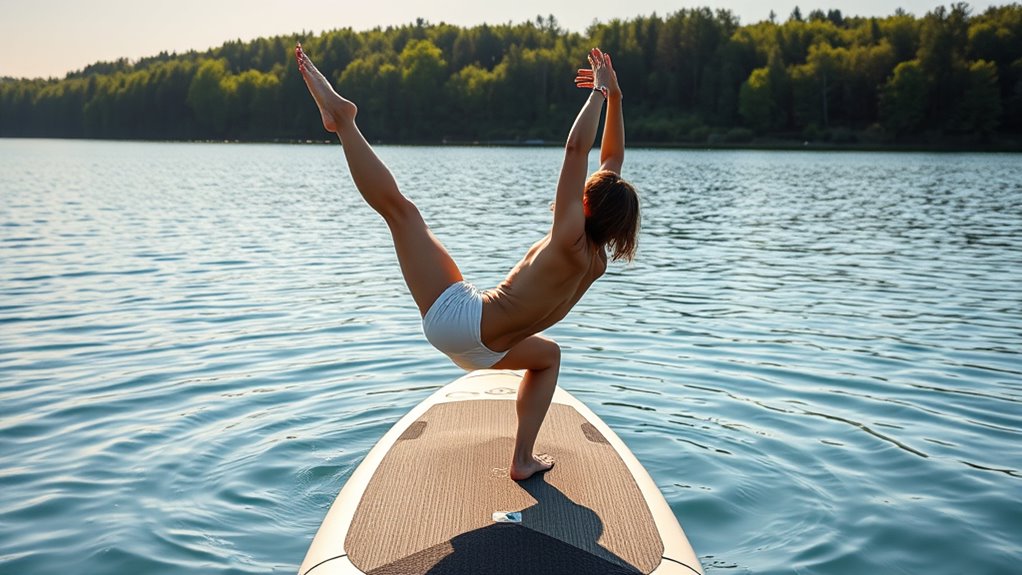You can enhance your flexibility with water-based routines that combine gentle stretches, such as seated forward bends and spinal twists, with dynamic warm-ups like leg swings and arm circles. These exercises improve mobility, release muscle tension, and boost muscular control while taking advantage of water’s natural resistance and calming environment. Focus on slow, controlled movements, good posture, and deep breathing to maximize benefits. Keep exploring for more tips to transform your water stretching sessions into a full, relaxing routine.
Key Takeaways
- Incorporate water-based stretches like seated forward bends and spinal twists to enhance flexibility while maintaining buoyancy.
- Use dynamic warm-up movements such as leg swings and arm circles on stable or floating platforms to activate muscles.
- Practice gentle yoga poses like child’s pose and cat-cow in water to improve spinal mobility and promote relaxation.
- Focus on slow, controlled movements combined with deep breathing to safely deepen stretches and reduce muscle tension.
- Finish with cool-down stretches and mindful breathing in water for optimal muscle relaxation and flexibility improvement.

Ever wondered how to improve your mobility and reduce muscle tension? Performing flexibility stretch routines on water can be an effective and invigorating way to achieve that. When you’re out on the water, the gentle instability of the surface challenges your muscles and stabilizers, making your stretching routine more engaging and beneficial. To get started, focus on a combination of yoga poses and dynamic stretches that are suited for this environment. These movements help loosen tight muscles and enhance your range of motion, all while enjoying the calming effect of being on the water.
Begin with some basic yoga poses that can be safely performed on a floating platform or boat deck. For example, try a seated forward bend to stretch your hamstrings and lower back. Sit with your legs extended, hinge at your hips, and reach toward your toes. You’ll notice how the water’s gentle sway makes your muscles work a little harder to maintain balance, deepening the stretch. Follow this with a gentle spinal twist, sitting upright and twisting your torso to one side, then the other. This pose not only increases spinal flexibility but also helps release tension accumulated from daily stress.
Practicing seated forward bends and spinal twists on water enhances flexibility and relieves tension naturally.
Incorporate dynamic stretches to warm up your muscles and increase blood flow. These are active movements that mimic the stretches but are performed in a controlled, fluid manner. For instance, leg swings or arm circles can be executed while standing on the water’s surface or on a stable platform. As you swing your leg forward and back or circle your arms, the water’s instability forces your stabilizer muscles to engage more intensely. This added challenge enhances flexibility and muscular control, making your routine more effective.
As you progress, add in more targeted stretches like lunges with a side stretch or hip openers. These can be done by stepping into a lunge position and reaching overhead or to the side, feeling the stretch through your hips and legs. The water’s movement encourages you to maintain proper posture and alignment, preventing overstretching or injury. Keep your movements slow and controlled, focusing on breathing deeply to facilitate muscle relaxation.
Completing your routine with some gentle, slow-paced yoga poses like child’s pose or cat-cow can help cool down and relax your muscles. The natural environment of water adds a calming element that enhances your flexibility practice, making it not only effective but also enjoyable. With consistency, these water-based routines can considerably improve your mobility, reduce muscle tension, and leave you feeling invigorated and limber.
Frequently Asked Questions
Can Beginners Safely Perform Water-Based Flexibility Stretches?
Yes, you can safely perform water-based flexibility stretches as a beginner. Hydrotherapy benefits include reduced joint strain and improved mobility, making stretching easier and safer. Aquatic yoga is an excellent option because it combines gentle stretching with the supportive water environment, helping you build flexibility gradually. Just start slow, listen to your body, and consider guided sessions to guarantee proper technique and safety.
What Equipment Is Needed for Water Flexibility Routines?
You only need minimal equipment for water flexibility routines, mainly just your body and some optional accessories. Water resistance and buoyancy effects naturally assist your stretching, so you don’t require weights or bands. You might consider using foam noodles, kickboards, or resistance gloves to enhance your workout, but they’re not essential. Focus on your movements, and let the water’s natural properties support your flexibility and balance.
How Often Should I Do These Water Stretches?
You should practice water stretches about three to four times a week, allowing your muscles to relax and rejuvenate. Imagine gliding through the water, feeling the gentle resistance that enhances hydrotherapy benefits. Incorporate aquatic yoga routines regularly to improve flexibility and reduce stress. Consistent practice not only boosts your physical well-being but also offers mental clarity, making each session a invigorating escape into serenity and strength.
Are Water Stretches Effective for Improving Overall Flexibility?
Yes, water stretches are effective for improving overall flexibility because of their hydrotherapy benefits. The buoyancy of water reduces joint stress, allowing you to perform aquatic flexibility exercises safely and comfortably. Regularly practicing these stretches enhances your range of motion, muscle relaxation, and joint health. Incorporate them consistently into your routine to see noticeable improvements, all while enjoying the soothing, low-impact environment water provides.
Can Water Stretching Help With Injury Recovery?
Water stretching can profoundly aid your injury recovery because of the incredible hydrotherapy benefits. Water resistance gently supports your movements, reducing strain and promoting healing faster than traditional methods. It helps increase blood flow, reduce swelling, and restore flexibility safely. By incorporating water stretches into your rehab, you harness a natural, soothing environment that accelerates recovery, making your healing journey more effective and less painful.
Conclusion
Now that you’ve explored these water-friendly flexibility stretches, you’re ready to move with the ease of a gentle wave. Incorporate these routines into your day, and you’ll find your body becoming more adaptable and relaxed — like a boat drifting effortlessly on calm seas. Remember, consistency is key, so keep practicing and enjoy the soothing flow of your improved flexibility. Immerse yourself in these stretches regularly and ride the waves of your own progress with confidence.









